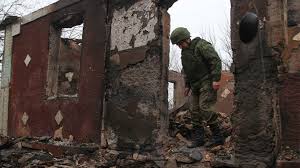This moral predicament is captured in a scene in “Donbass” in which thugs tie a Ukrainian soldier to a telegraph pole and entice the crowd to lynch him. “I wanted to show the mechanism for working people into a state of ecstasy,” Mr Loznitsa says. The scene reconstructs a real video posted on YouTube, and is more effective for the absence of a narratorial voice. He could never film such an event directly, Mr Loznitsa avers: not only would that “make you an accomplice”, the presence of a camera would “draw in the audience to participate”. Often he conveys a sense that he is telling one story among many. Elsewhere in “Donbass”, for example, a businessman whom the militia are extorting is transferred to a holding room—where he finds a legion of other detainees pleading for help on their phones. The sequence, like many in Mr Loznitsa’s films, seems at once hyperreal and mythic.

The interplay between audience and spectacle, and the use of news footage to validate lies, are at the heart of “The Trial”, which he made just after “Donbass”. One is a feature, the other is shaped entirely from archive material, but in their preoccupations, the films are twins. “The Trial” reconstructs a tribunal that took place in Moscow in 1930. A group of Soviet engineers and economists were accused of forming the “Industrial Party”, which in collusion with France had supposedly plotted against the Bolshevik government.
译文由可可原创,仅供学习交流使用,未经许可请勿转载。












